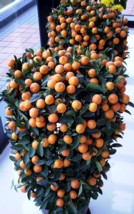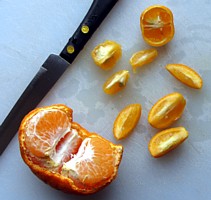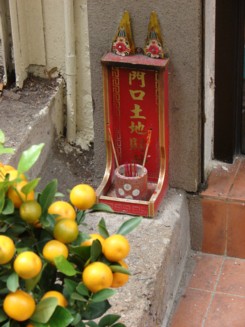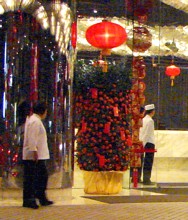
Content created: 2013-02-07
File last modified:

 |
| Calamondin (or kalansi) Trees in an Office Lobby. |
At New Year time, pretty much any round, yellowish fruit is thought to look like money, and oranges, tangerines, and kumquats are all used as decoration. Oranges (jú or júzi) 橘子 appear in the famous “Filial Exemplar” story about a little boy named Lù Jī 陆绩, who swiped some from a host but was forgiven and even praised because he took them to give to his mother. (Story Link)
In addition to the association with filial devotion conferred on them by the well-known story, the syllable jú is phonetically similar enough in the mouths of some speakers to zhù 祝, “wish,” which, at New Year time, evokes the phrase Wèi nǐ zhùfú 为你祝福 “Blessings on you,” an appropriate New Year greeting. Oranges are therefore part of the repertoire of New Year foods.
In southern China, where oranges are actually grown, the logic for their inclusion is similar, but the words may be different. One of the several words for "orange" in Cantonese, of which more below, is gām (Mandarin: gān ) 柑, which is exactly homonymous with another Cantonese word, gām, meaning gold (Mandarin: jīn) 金. Around the time of the New Year holiday, when people admit to thinking about money 24/7, the more gām you can surround yourself with, the better.
Kumquats, being little round gold things, are even actually called "money oranges" gāmgām 金柑 in Cantonese. (In Mandarin they are jīnqiánjú 金钱桔). They too are of course linked to New Year.
 |
| Calamondin (or Kalansi) (top) Compared with Kumquat (right) and Orange (left). |
One member of the orange family that is grown in Guǎngdōng, including the area around Hong Kong, is an extremely cute dwarf orange called a calamondin (Citrus mitis) or in botanical Chinese, jiālā-měngdì-yàjú in Mandarin and gala-mùnghdeih-a'āat in Cantonese 加拉蒙地亚桔. (It may or may not be the same thing as a kalansi).
Together with kumquats, calamondins (or kalansis) are forced into fruiting in time for New Year, when little bushes covered in gold fruit are suddenly to be seen in pots all around. And even though calamondins (or kalansis) aren't properly called gām, they seem to have got sucked into the same semantic vortex and are considered gold (gām) enough to be inspiring, keeping thousands of landscape nurseries going, all across southern China.
Calamondins have an additional advantage in some environments, and that is that they taste terrible, and the attractive fruits are therefore not stolen by passing children. If there is a more sour, nastier little fruit in all world than a calamondin (or a kalansi), you wouldn't want to meet it. Some people say it can be packed in salt for a while, then made into a tea that cures a soar throat. It probably also cures thieves and obstreperous children.
 |
| Calamondin (or Kalansi) Tree with Money God Shrine on a Hong Kong Merchant's Doorstep. |
For those with less concern about homonyms or with a larger space to decorate, potted trees with mandarin oranges turn up. I am told there is a variety with a name that sounds like "luck," — Cantonese: gut, or something like it — but I haven't knowingly found one. (Just no luck.)
In Taiwan I was always mixing up the two Chinese words for orange that we met above: gān (Cantonese: gām, Hokkien: kam-á) 柑 and jú (Cantonese āat) 橘. I called all oranges indiscriminately jú because it was the only word I had learned in my Chinese class. And I was always being laughingly corrected. Gān wouldn’t have fared any better.
It develops that jú has no colloquial cognate in Taiwanese Hokkien. (If it did, it would probably be kî, but it doesn’t, so saying kî would only get you a gaping stare.) And the word I had learned, jú, therefore has no real currency in Taiwan Mandarin. So it was in fact always the wrong word. (I have long suspected that the Pekinese chauvinist who wrote the textbook did that on purpose.)
 |
| Calamondin (or kalansi) Tree Outside Up-Scale Hotel. |
A lot of oranges in Taiwan — probably the same ones called jú in Chinese class — were in fact called liǔdīng (Hokkien: liú-teng, Cantonese: láuhdīng) 柳丁, which ought to mean "willow nails," except that it doesn't. It means oranges.
That local usage seems to have bothered post-war mainlander immigrants as much as it bothered me, but Taiwanese reached a kind of compromise with them by changing the “nails” (dīng 丁) part to yet another Mandarin word for orange, chéng 橙, producing "willow orange" rather than “willow nails,” which ought to be recognizable to everybody.
The Taiwanese wrote liǔdīng this way when compelled to do so, but continued to pronounce the compound liǔdīng and not liǔchéng, since liǔdīng (or more exactly liú-teng, the Hokkien cognate) was obviously what the fruit was really named. As a result, modern dictionaries now give two different readings for the character 橙: It is dīng when it comes after liǔ, and chéng every place else. Since dīng 丁 is an old word both for nails and for sons, oranges in Taiwan had long had an association with fecundity, but were not specifically New Year things. The non-nail writing tended to obscure that.
As a bit of Taiwanese colloquial Mandarin, liǔdīng was certainly not the sort of word anybody would have taught in an American Mandarin class. Besides, I couldn't decide which kind of orange it referred to anyway.
In fact, there are actually four roots in Chinese, two of which have identical pronunciations in Mandarin, and all of which most dictionaries happily translate both orange and tangerine (except when they translate them some other way):
 |
|
Two Oranges from a Market in Hong Kong. The one on the left was labeled lúgān (Cantonese: lòuhgām) 芦柑; the one on the right, xiānchéng (Cantonese: sīncháang) 鲜橙. Lú is a kind of inedible reed. Xiān means "savory" and is usually associated with sea food. Go figure. |
Worse yet, a Cantonese compound made up of the first two of these (柑橘 gāmgwāt) is the origin of the English word “kumquat,” the same kumquat that, in Mandarin, is the money orange, for which the element jú 桔 is used (except when 橘 is used instead).
A gāmgwāt (Mandarin: gānjú) 柑橘 is not really a kumquat, by the way, even though it is where English gets that word. It is translated "mandarin orange" by most dictionaries (although everybody knows mandarin oranges come in cans).
Indeed, some native Cantonese speakers seem never to have heard the word gāmgwāt, opining that it was made up by Americans to confuse the opposition.
Talking to Chinese speakers, they seem almost as confused as I am, at least outside of a market, where things have labels. (Of course, being confused doesn’t prevent a person from being a stout defender of his own family’s local usage.)
In general, if the skin peals off easily, the element gān 柑 probably ought to be part of the name. If it doesn't then it probably shouldn't.
Fortunately, an orange by any other name still smells like money.